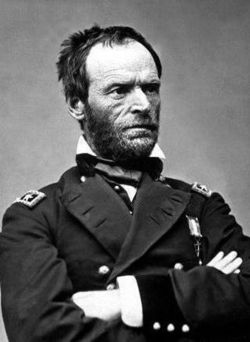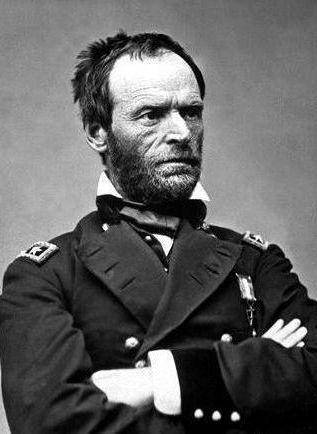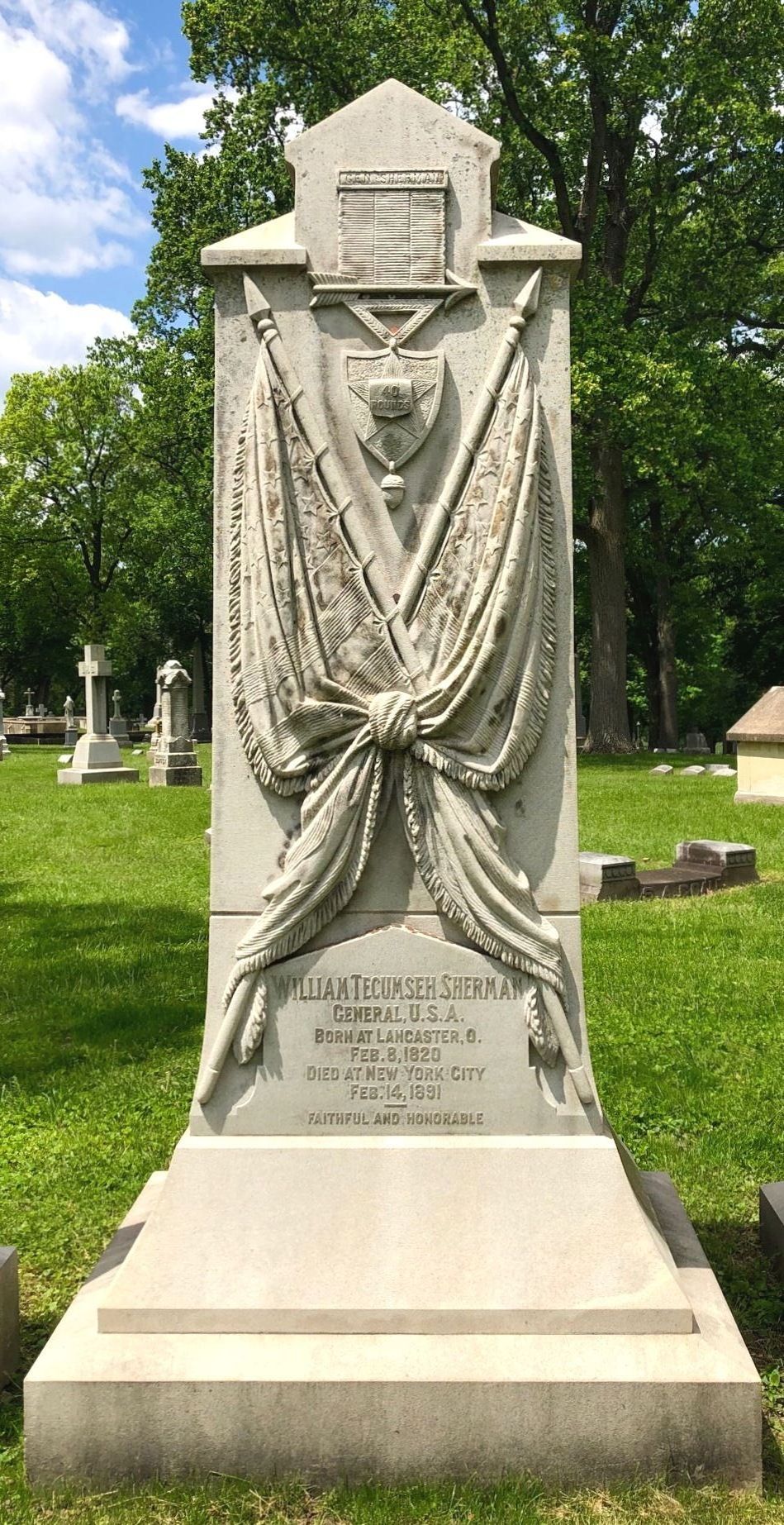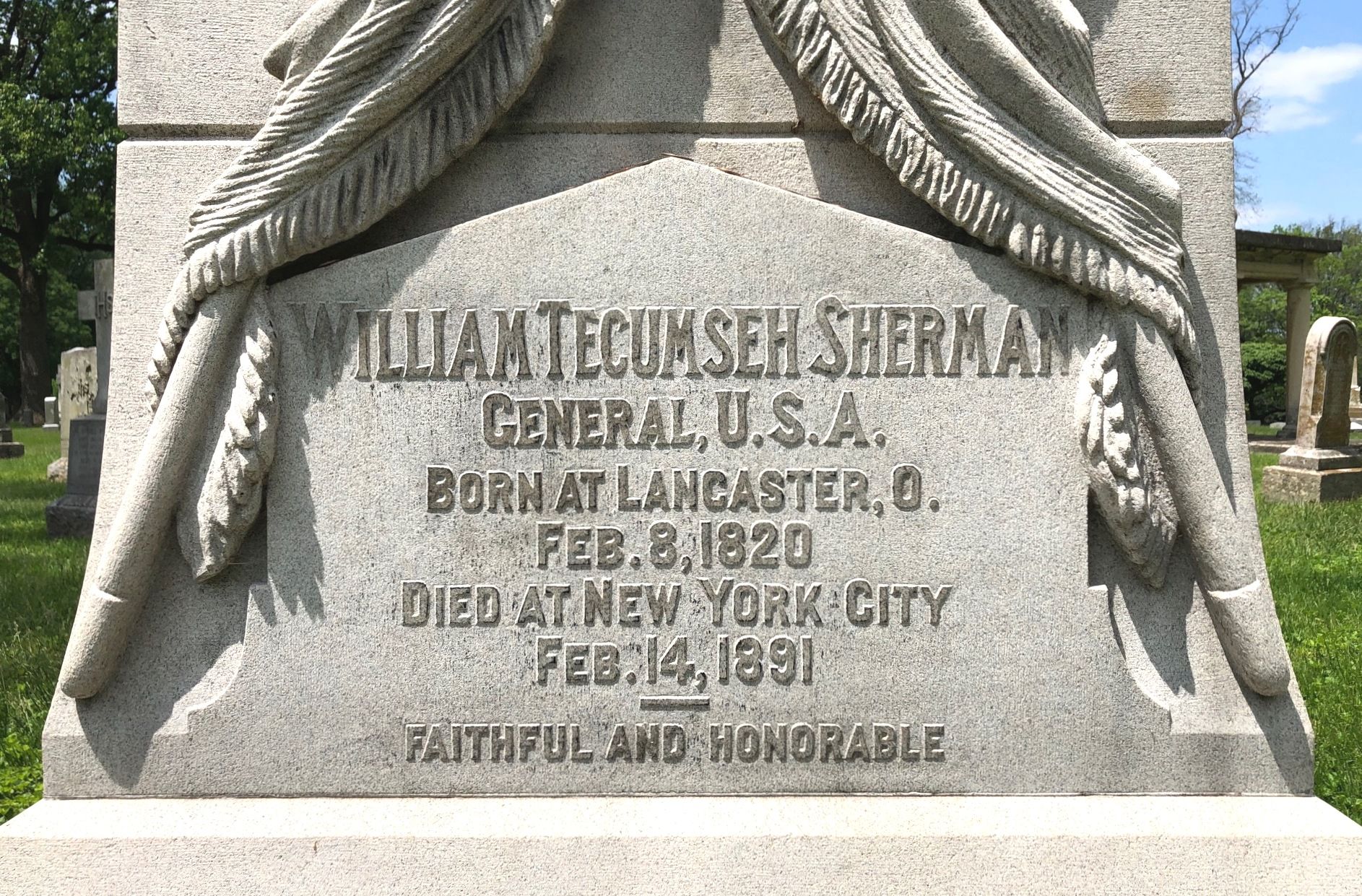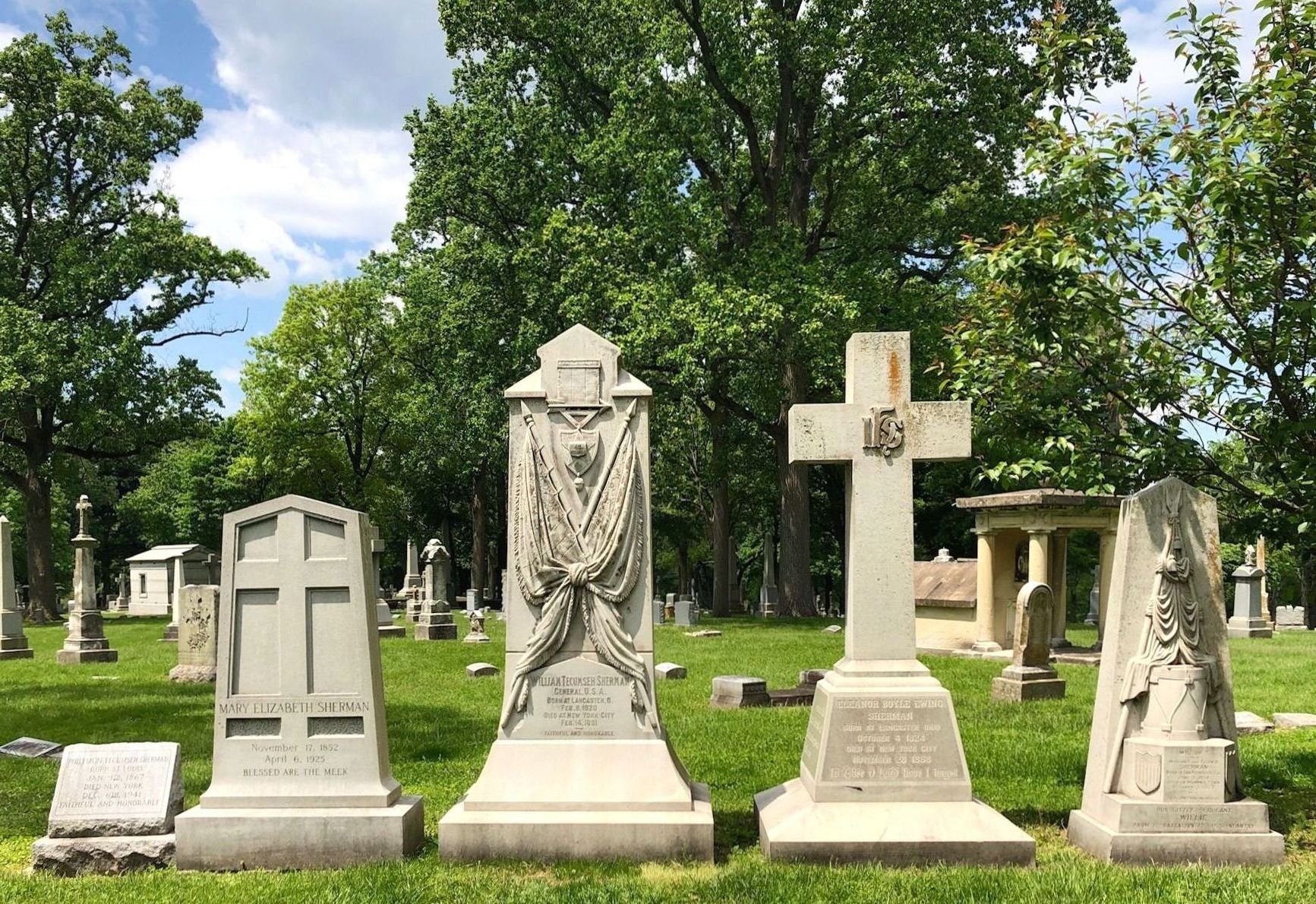Civil War Union Major General and later General of the United States Army. William Tecumseh Sherman was born 8 February 1820 in Lancaster, Ohio, into a family of eleven. His father, a lawyer and jurist, died when he was nine, leaving the family destitute. The children were parceled out to relatives and friends. William was sent to the family of Thomas Ewing, a neighbor and friend who was a U.S. Senator from Ohio [1830-1836] and later a member of the cabinet under four U.S. Presidents, William Henry Harrison, John Tyler, Zachary Taylor, Millard Fillmore [he was appointed Secretary of War by Andrew Johnson, but the Senate refused to confirm him]. Sherman's early education was at the Lancaster Academy where his scholastic record earned him an appointment to West Point at age sixteen. Graduating 6th out of 42 in the class of 1840, he was commissioned a Second Lieutenant in the 3rd U.S. Artillery and saw action in Florida toward the end of the Second Seminole War. Sherman then served in South Carolina, Georgia, and California. He saw no action in the Mexican-American War. In 1850 he married Ellen Boyle Ewing, daughter of Thomas Ewing. Sherman resigned from the Army in 1853 to pursue a career in banking and as a lawyer, but with little success. When the bank failed in the Panic of 1857, he accepted the position as the first President of the Louisiana State Seminary of Learning & Military Academy in Pineville, Louisiana. The institution would later become Louisiana State University. The Civil War brought him back to active duty with a Colonel's commission from President Lincoln. Lincoln offered him a General's commission but he refused. He thought there were too many Generals already. As a Colonel, and later General, he participated in a number of major battles, e.g., leading a brigade at Bull Run, a division at Shiloh [under U.S. Grant] and four divisions at Vicksburg [also under Grant]. Most of all he is remembered for the Georgia campaign and his March to the Sea. He led an army of 62,000 men with 35,000 horses and 2,500 wagons on an overland march from Atlanta to Savannah on a mission to break the will of Georgia and show the Confederacy-and the rest of the world-the futility of the South continuing the war. He severed his army's supply line, allowing the troops to forage and sustain themselves by living off the land during the march. Between Atlanta and Savannah, a swath of utter destruction was left by Sherman's Army. They destroyed public and private buildings in Atlanta, except for most churches and hospitals. Railroad tracks, bridges, and rolling stock were rendered useless. Towns, plantations and farms were burned and looted. But South Carolina, the first state to secede from the Union, received most of the vengeance of the army. Columbia, the state capitol, was burned to the ground. The results of this march, together with Grant's victories in Virginia, were major contributions to the war's end. After the war, under President Grant, Sherman became Commanding General of the United States Army and served in this high post until his retirement in 1884. He oversaw the completion of the transcontinental railroad and the defeat of the plains Indian tribes. Another important achievement was the establishment of the Command School at Ft. Leavenworth, Kansas. His memoirs, a two-volume classic, were published in 1875. After retirement, Sherman moved to New York City and lived there the rest of his life. He loved the theatre and was much in demand as a speaker at dinners and banquets. In 1884, Sherman was courted by the Republicans to became their presidential candidate. He responded to them with typical brusqueness, "If nominated, I will not run, if elected I will not serve." He died in New York City in 1891 at age 71. A brief service was held at his residence followed by a grand procession, escorting his coffin to a train waiting to convey his body to St Louis, Missouri, for interment in the family plot. Upon arrival at Union Depot in St. Louis, a caisson drawn by four black horses carried his remains through downtown St. Louis to Calvary Cemetery for burial beside his wife, Ellen, and two of their children. His son, Fr. Thomas Sherman, S.J., conducted a funeral Mass. The Sherman legacy includes countless streets, schools, and buildings that bear his name. Hundreds of books have been written about the General. A statue of Sherman on his horse, with Nike, the Greek Goddess of Victory carrying an olive branch, is located at Grand Army Plaza, the corner of 5th Avenue and 59th Street in New York City. The statue was the 11-year project of Augustus Saint Gaudens. Its recent bronze regilding was a gift of Donald Trump. The General's place of birth, the Sherman House Museum, in Lancaster, is a National Historic Landmark. It is also the birthplace of his brother, Senator John Sherman of Ohio, who authored the Sherman Antitrust Act. The General Sherman Tree, located in Sequoia National Park, bears his name and is the biggest single-trunk tree known of in the world. The M4 Sherman tank, which was the mainstay of the Allies during World War II, was named after this famous Civil War General. He has been honored four times by the Postal Service, in 1893 and again in 1895 with a definitive 8¢ stamp. He shared a 3¢ commemorative stamp with Generals U.S. Grant and Phil Sheridan in 1937 and then in 1995 was included in a set of twenty 32¢ commemorative stamps focusing on famous individuals and battles in the Civil War.
Civil War Union Major General and later General of the United States Army. William Tecumseh Sherman was born 8 February 1820 in Lancaster, Ohio, into a family of eleven. His father, a lawyer and jurist, died when he was nine, leaving the family destitute. The children were parceled out to relatives and friends. William was sent to the family of Thomas Ewing, a neighbor and friend who was a U.S. Senator from Ohio [1830-1836] and later a member of the cabinet under four U.S. Presidents, William Henry Harrison, John Tyler, Zachary Taylor, Millard Fillmore [he was appointed Secretary of War by Andrew Johnson, but the Senate refused to confirm him]. Sherman's early education was at the Lancaster Academy where his scholastic record earned him an appointment to West Point at age sixteen. Graduating 6th out of 42 in the class of 1840, he was commissioned a Second Lieutenant in the 3rd U.S. Artillery and saw action in Florida toward the end of the Second Seminole War. Sherman then served in South Carolina, Georgia, and California. He saw no action in the Mexican-American War. In 1850 he married Ellen Boyle Ewing, daughter of Thomas Ewing. Sherman resigned from the Army in 1853 to pursue a career in banking and as a lawyer, but with little success. When the bank failed in the Panic of 1857, he accepted the position as the first President of the Louisiana State Seminary of Learning & Military Academy in Pineville, Louisiana. The institution would later become Louisiana State University. The Civil War brought him back to active duty with a Colonel's commission from President Lincoln. Lincoln offered him a General's commission but he refused. He thought there were too many Generals already. As a Colonel, and later General, he participated in a number of major battles, e.g., leading a brigade at Bull Run, a division at Shiloh [under U.S. Grant] and four divisions at Vicksburg [also under Grant]. Most of all he is remembered for the Georgia campaign and his March to the Sea. He led an army of 62,000 men with 35,000 horses and 2,500 wagons on an overland march from Atlanta to Savannah on a mission to break the will of Georgia and show the Confederacy-and the rest of the world-the futility of the South continuing the war. He severed his army's supply line, allowing the troops to forage and sustain themselves by living off the land during the march. Between Atlanta and Savannah, a swath of utter destruction was left by Sherman's Army. They destroyed public and private buildings in Atlanta, except for most churches and hospitals. Railroad tracks, bridges, and rolling stock were rendered useless. Towns, plantations and farms were burned and looted. But South Carolina, the first state to secede from the Union, received most of the vengeance of the army. Columbia, the state capitol, was burned to the ground. The results of this march, together with Grant's victories in Virginia, were major contributions to the war's end. After the war, under President Grant, Sherman became Commanding General of the United States Army and served in this high post until his retirement in 1884. He oversaw the completion of the transcontinental railroad and the defeat of the plains Indian tribes. Another important achievement was the establishment of the Command School at Ft. Leavenworth, Kansas. His memoirs, a two-volume classic, were published in 1875. After retirement, Sherman moved to New York City and lived there the rest of his life. He loved the theatre and was much in demand as a speaker at dinners and banquets. In 1884, Sherman was courted by the Republicans to became their presidential candidate. He responded to them with typical brusqueness, "If nominated, I will not run, if elected I will not serve." He died in New York City in 1891 at age 71. A brief service was held at his residence followed by a grand procession, escorting his coffin to a train waiting to convey his body to St Louis, Missouri, for interment in the family plot. Upon arrival at Union Depot in St. Louis, a caisson drawn by four black horses carried his remains through downtown St. Louis to Calvary Cemetery for burial beside his wife, Ellen, and two of their children. His son, Fr. Thomas Sherman, S.J., conducted a funeral Mass. The Sherman legacy includes countless streets, schools, and buildings that bear his name. Hundreds of books have been written about the General. A statue of Sherman on his horse, with Nike, the Greek Goddess of Victory carrying an olive branch, is located at Grand Army Plaza, the corner of 5th Avenue and 59th Street in New York City. The statue was the 11-year project of Augustus Saint Gaudens. Its recent bronze regilding was a gift of Donald Trump. The General's place of birth, the Sherman House Museum, in Lancaster, is a National Historic Landmark. It is also the birthplace of his brother, Senator John Sherman of Ohio, who authored the Sherman Antitrust Act. The General Sherman Tree, located in Sequoia National Park, bears his name and is the biggest single-trunk tree known of in the world. The M4 Sherman tank, which was the mainstay of the Allies during World War II, was named after this famous Civil War General. He has been honored four times by the Postal Service, in 1893 and again in 1895 with a definitive 8¢ stamp. He shared a 3¢ commemorative stamp with Generals U.S. Grant and Phil Sheridan in 1937 and then in 1995 was included in a set of twenty 32¢ commemorative stamps focusing on famous individuals and battles in the Civil War.
Bio by: Ronald L. Hoover
Inscription
GENERAL U.S.A.
FAITHFUL AND HONORABLE
Family Members
-
![]()
Judge Charles Taylor Sherman
1811–1879
-
![]()
Mary Elizabeth Sherman Reese
1812–1900
-
![]()
James Sherman
1813–1864
-
![]()
Amelia Sherman McComb
1816–1862
-
![]()
Julia Ann Sherman Willock
1818–1842
-
![]()
Lampson Parker Sherman Sr
1821–1900
-
![]()
John Sherman
1823–1900
-
![]()
Susan Denman Sherman Bartley
1825–1876
-
![]()
Maj Hoyt Sherman
1827–1904
-
![]()
Frances Beecher "Frannie" Sherman Moulton
1829–1889
-
![]()
Maria Ewing "Minnie" Sherman Fitch
1851–1913
-
![]()
Mary Elizabeth "Lizzie" Sherman
1852–1925
-
![]()
William Tecumseh "Willie" Sherman Jr
1854–1863
-
![]()
Rev Thomas Ewing Sherman
1856–1933
-
![]()
Eleanor Mary Sherman Thackara
1859–1915
-
![]()
Rachel Ewing "Rachey" Sherman Thorndike
1861–1919
-
![]()
Charles Celestine Sherman
1864–1864
-
![]()
Philemon Tecumseh Sherman
1867–1941
Advertisement
See more Sherman memorials in:
Explore more
Sponsored by Ancestry
Advertisement
